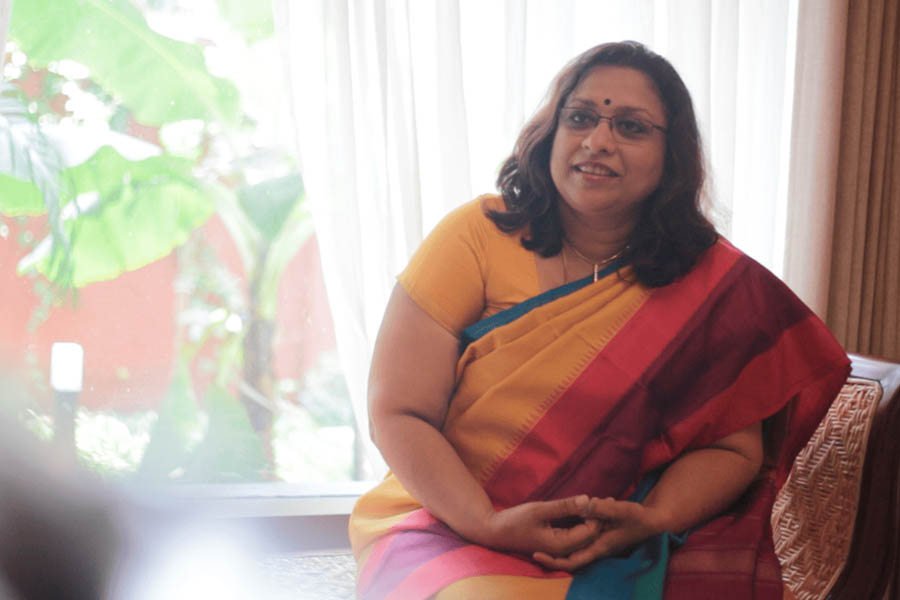Wearing sarees is a way of life for me
Dr. Uma Ram, a leading obstetrician and gynaecologist in Chennai, is no stranger to the saree. With an enviable collection of sarees, some as old 23 years, one can call her a true saree patron, who grew up appreciating the intricacies of the six-yard weave. So, it comes as no surprise when she says wearing sarees is a way of life for her.
“My grandparents and aunts had such lovely silks, this was something I grew up appreciating… Culturally, it’s what we have always worn. I am very comfortable in it,” says Dr. Uma, in a free-wheeling interview to Tulsi Silks.
Excerpts from the interview…
How would you describe your love for sarees?
I enjoy wearing sarees, I appreciate the work, effort and artistry that go into making a saree. When we were in school, things were a little different from how they are now. I don’t know if young girls today have the same excitement about wearing a saree for the first time. When we were in school, it was a big deal to wear a saree. I remember choosing the saree for the school photograph; it was a given that we would all wear a saree when we completed school. My grandparents and aunts had such lovely silks, this was something that I kind of grew up appreciating. I don’t know if there was a specific point in time when the fascination for the saree started. It was a way of life, really.
Do you remember the first couple of sarees you wore?
I think the first saree I ever got was a gift from a distant relative who had come from Canada. I was only 14 years old. It was a pale blue and black synthetic saree. I remember wearing it much later. Then I remember buying a saree for my brother’s poonal. I still have it because I love the colours and it goes with the sentiment.
What about your first few sarees from Tulsi?
The first saree I bought from Tulsi was for my thalai Deepavali. I think that was the year the store started. Subsequently, for the valaikappu, I got the traditional black saree. A Baluchera silk in black with orange, I still wear it, though it is nearly 23 years old. As with other things, the early sarees are usually bought for an occasion. So there are memories and stories with them. For these reasons, you keep them even if the silk has worn a little thin.
What does saree wearing mean to you? Why do you wear a saree to work?
Why not? Why should one not wear a saree to work? It is our dress. Culturally, it’s what we have always worn. I am very comfortable with it. I am far more comfortable in it than I am in a pair of trousers, even if it that is convenient. The saree is professional, it’s smart. You can’t go wrong with it. I wear sarees to work on a regular basis, about 95 per cent of the time.
To answer your question in a different way, when you are much younger and you are starting off, especially as a doctor, especially as an obstetrician, you have to deal with families who are coming to you many times to have a baby. They know you are young and in the early years of practice. So, a saree tends to give you that little bit of seriousness and makes you a little bit more professional, if I may say so.
The saree is something I can get in and out of in a few minutes, to be honest. Many of my juniors ask me how I do that so quickly. If you have done if so often, you can do it quickly. I don’t see it as being an effort. Most of us at workwear sarees. Quite a few of my juniors wear sarees, a lot of the time. In fact, a couple of people have commented that it’s nice to see all of us in sarees at the clinic.
What is the trend you see today?
Back then, wearing sarees wasn’t so uncommon. Today, I see a change. Some of the younger doctors are not that comfortable wearing a saree. They need an occasion to wear it. The saree is looked at as a dress you will wear for an occasion rather than an everyday dress. That’s a shift, which is just changing as it happens.
Would you tell the younger generation to start appreciating the art and realise the value of the saree?
If someone is not comfortable working in a particular dress, then you can’t force them to change the way they are. A lot of this change has come from the corporate world because it is considered the done thing to wear Western clothing when you make presentations. There is a certain culture that has come in. It is considered more chic to be in Western clothing.
I don’t know if it is good or bad but I think it is important to reflect on what that change would do to the weaving industry. If we were to buy sarees only for occasions, then most people will not be buying a certain line of sarees (day to day wear). And that will have its impact on the people who are making them. I would be more concerned about this impact than whether the change is good or bad.
Often, the contribution of the weavers goes unnoticed. So, when we read out the letters from patrons, the weavers were elated. What are your thoughts on this?
I think it’s very important that their work is appreciated. When I wear a nice saree and I am complimented for the saree, most of the credit should go to the weaver, right? But I don’t know if we actually think about this at that point in time. So, giving feedback would be a good thing.
Many times, when we buy a saree, we are not aware of the intricacies of the weaving or the technique that has gone into it, which may be the reason why we don’t appreciate it. We know there is somebody sitting on the loom and weaving the saree, but we don’t know what effort it takes to merge the colours or get the pattern right. Even a regular saree wearer wonders why a saree is so pricey and may not buy it because of this. But if a portion of the price genuinely goes to the person who has created it, then it’s a meaningful exercise. This is a point to pause and think about.




